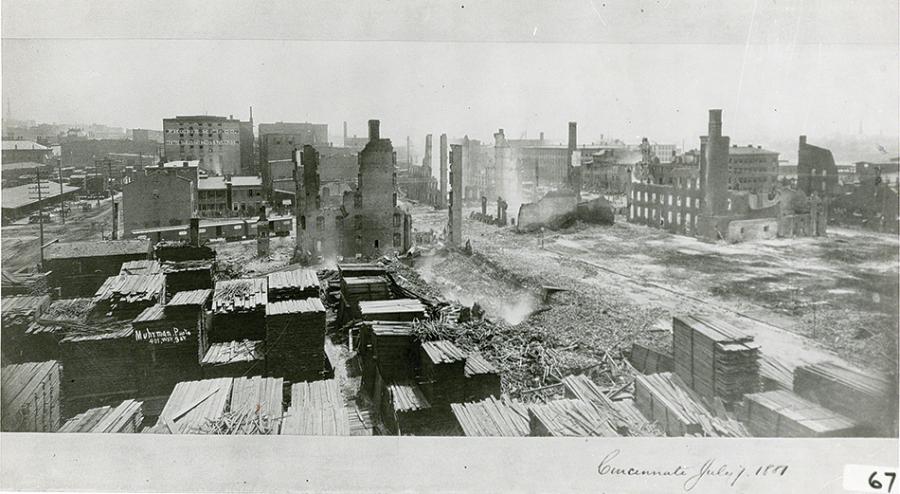For our February 2017 “Lost City” issue, we remember what time, disasters, and the wrecking ball have taken away.
On a beastly hot afternoon in July 1881, a fire in a toy factory almost destroyed Cincinnati.
The culprit was wood shavings at P.J. Marqua & Co., which manufactured baby carriages and rocking horses in the neighborhood tucked between Second Street and the river, about eight blocks west of the Public Landing—the west side of “the bottoms.” As bad luck would have it, the tinder-filled four-story Marqua building was close to furniture factories and a foundry, all full of equally combustible material. It was the perfect prescription for disaster. The blaze ignited warehouses and lumber piles, tenements and saloons. It spread to buildings on Second Street, burning so hot and so fast that there was real fear it would roar through the city. It took five hours for firemen to get it under control, and it was still smoldering when photographer Charles H. Muhrman captured this panorama.

Cincinnati Museum Center. Cincinnati History Library & Archives. General Photos. Cincinnati, July 1881 (Muhrman photo)
If the flames had reached the city center, it would have been a defining moment for Cincinnati. Like Chicago after the Great Fire of 1871, the Queen City would have faced rebuilding on a monumental scale. But total destruction was avoided, and today the Marqua Fire and the buildings it leveled aren’t even a blip on the radar screen of local history.
But fire has taken treasures—most notably the grandly turreted Chamber of Commerce building at Fourth and Vine. It was built in 1889 and burned in 1911, and even though it was only part of civic life for 22 years and disappeared before anyone who might be reading this was born, Cincinnatians still mourn the place.
In 2006, the Betts House museum—the oldest surviving brick building in the city—presented an exhibit that explored the why? behind vanished structures. Lost Cincinnati: Why Buildings Die examined the forces that have changed our built environment: fire and natural disasters; neglect and structural failure; and the impact of the automobile, which sent Cincinnatians to the suburbs. Financial factors account for many losses, from the flagging fortunes of the once-elegant Sinton Hotel to the seldom-profitable whimsy of WNOP, the jazz station that floated on oil drums. Functional obsolescence killed off the city’s inclines, benched Crosley Field, and made a ghost of our fabled Victorian-era hoosegow, the Workhouse.
In the parlance of Lost Cincinnati, “changing land uses”—decisions by owners, developers, and power brokers—have remade the landscape, too. It’s the reason the city’s picturesque Lincoln Park, a place where the West End’s tenement families enjoyed fresh air and green grass in 1900, was swept away when Union Terminal was built in the 1920s. And it’s the reason historic Wesley Chapel, Allen Temple, Chapel of the Holy Spirit, and the archdiocese’s Fenwick Club ascended to heaven, demolished to make way for Procter & Gamble’s corporate expansion. Of course there’s urban renewal, the postwar effort to save deteriorating inner city streets by leveling them. Urban renewal obliterated the West End’s Kenyon-Barr neighborhood. Even the name was snuffed out.
Why do Cincinnatians care so much about lost buildings, parks, department stores, old-time movie houses, and breweries—even those that have no great historic significance? Sometimes it’s because they’re stitched into the fabric of our lives. It’s not about Crosley Field; it’s about going to the game with Dad. It’s not about Pogue’s; it’s about back-to-school shopping with Mom.
We’re also a city with a high regard for aesthetics. Even if we disagree vociferously about what’s being built now, we do seem to recognize stirring lines and inventive design once they are gone, and we mourn the missing places that might have enlivened our city today. The Old Main Library at 629 Vine, with its marble floor, spiral stairs, and towering stacks, must have seemed aesthetically irrelevant at the dawn of the Atomic Age. Today, however, we may beg to differ.
Looking at images of long-lost Queen City edifices, the lives they held come more sharply into focus. Sepia-toned shots of public markets, breweries, and packing plants summon up the men and women who built this city. Seeing the stoops of Kenyon-Barr helps makes the families who once lived there seem more real, more concrete.
Even Charles Muhrman’s image of the destruction wrought by the Marqua Fire is a window into another time. Muhrman wasn’t a photojournalist; his milieu was landscapes and handsome commercial establishments. But his studio was just a few blocks away, on the 400 block of West Third Street. So perhaps he knew some of the victims when he set up his camera to capture the sad scene. Here a huge tenement, there a dwelling barely larger than an outhouse—these were low-income families living side-by-side with firetrap factories in the flood-prone bottom-land by the river. That was life in one Cincinnati neighborhood in the hot summer of 1881. Lost, but not to be forgotten.





Facebook Comments